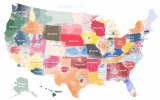If true as reported, that puts the B1G at 16 teams:
Illinois
Indiana
Iowa
Maryland
Michigan
Michigan State
Minnesota
Nebraska
Northwestern
Ohio State
Penn State
Purdue
Rutgers
UCLA
USC
Wisconsin
If you wanted to bring it to an even 20, who would you add? Assuming ACC schools are off-limits due to the Grant of Rights deal that extends through 2036, you are really looking at other Pac-12 (Grant of Rights expires in 2023) or Big 12 schools (Grant of rights expires in 2024).
Who you got?
Arizona
Oregon
Stanford
Washington
Cal
Colorado
Kansas
Oklahoma State (not an AAU member)
Iowa State
Personally, I would expand up the West Coast with Stanford, Oregon, and Washington, and then add Kansas. If they wanted 2 more, I would pick Colorado and Cal.
Illinois
Indiana
Iowa
Maryland
Michigan
Michigan State
Minnesota
Nebraska
Northwestern
Ohio State
Penn State
Purdue
Rutgers
UCLA
USC
Wisconsin
If you wanted to bring it to an even 20, who would you add? Assuming ACC schools are off-limits due to the Grant of Rights deal that extends through 2036, you are really looking at other Pac-12 (Grant of Rights expires in 2023) or Big 12 schools (Grant of rights expires in 2024).
Who you got?
Arizona
Oregon
Stanford
Washington
Cal
Colorado
Kansas
Oklahoma State (not an AAU member)
Iowa State
Personally, I would expand up the West Coast with Stanford, Oregon, and Washington, and then add Kansas. If they wanted 2 more, I would pick Colorado and Cal.


